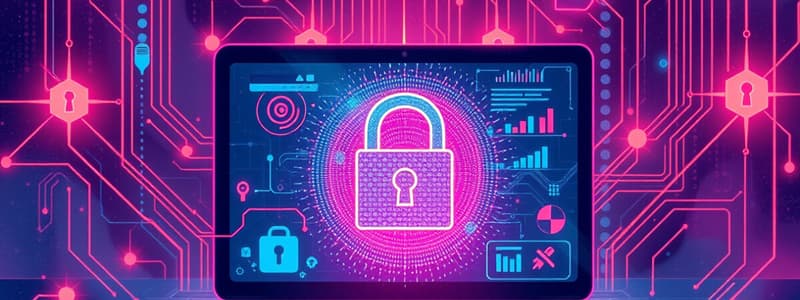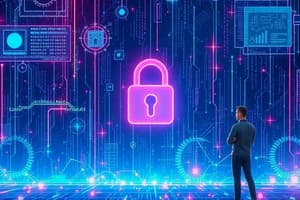Podcast
Questions and Answers
Which type of hacker focuses on discovering weaknesses to improve security?
Which type of hacker focuses on discovering weaknesses to improve security?
- Gray hat hacker
- Hacktivist
- Black hat hacker
- White hat hacker (correct)
Cyber criminals are usually solo attackers working independently.
Cyber criminals are usually solo attackers working independently.
False (B)
Name one example of an internal security threat.
Name one example of an internal security threat.
Mishandling confidential data
_____ hackers may exploit vulnerabilities and report them if it aligns with their agenda.
_____ hackers may exploit vulnerabilities and report them if it aligns with their agenda.
What is one motivation behind state-sponsored attackers?
What is one motivation behind state-sponsored attackers?
Match the following attacker types with their motivations:
Match the following attacker types with their motivations:
External threats can only come from highly skilled attackers.
External threats can only come from highly skilled attackers.
Define cyberwarfare in one sentence.
Define cyberwarfare in one sentence.
What is the primary goal of cybersecurity?
What is the primary goal of cybersecurity?
Your offline identity is the same as your online identity.
Your offline identity is the same as your online identity.
What are the three components of the CIA Triad in cybersecurity?
What are the three components of the CIA Triad in cybersecurity?
Cybercriminals seek both ____ and ____ by stealing your personal information.
Cybercriminals seek both ____ and ____ by stealing your personal information.
Match the types of organizational data with their descriptions:
Match the types of organizational data with their descriptions:
Which of the following is a consequence of a security breach?
Which of the following is a consequence of a security breach?
Script Kiddies are considered professionals in cyberattacks.
Script Kiddies are considered professionals in cyberattacks.
Name one method used to ensure confidentiality in cybersecurity.
Name one method used to ensure confidentiality in cybersecurity.
Study Notes
Cybersecurity Overview
- Ongoing efforts aim to protect networked systems and data from unauthorized access or damage.
- Distinction between offline identity (personal interactions) and online identity (cyberspace presence).
Data and Computing Devices
- Personal data types include medical, education, employment, and financial records.
- Data collection occurs through various avenues, necessitating an understanding of privacy laws.
- Personal data may be stored in multiple locations, including medical institutions and online servers.
- Computing devices serve as access points to personal data and generate user-related information.
Criminal Motivations
- Cyber criminals seek not only short-term financial gain but also aim to steal identities for long-term exploitation.
- Identity theft can lead to significant life consequences beyond financial loss.
Types of Organizational Data
- Traditional Data encompasses corporate, personnel, intellectual property, and financial data.
- Internet of Things (IoT) and Big Data represent a large network of devices generating vast amounts of data, creating new business and technology opportunities.
CIA Triad
- Confidentiality: Ensured through data encryption, authentication methods, and information exposure minimization.
- Integrity: Importance of data accuracy, consistency, and trustworthiness throughout its life cycle.
- Availability: Achieved by maintaining hardware, updating software, and creating backups for authorized user access.
Consequences of Security Breaches
- Possible outcomes include ruined reputation, vandalism, theft, lost revenue, and damaged intellectual property.
Types of Attackers
- Amateurs (Script Kiddies): Attackers with minimal skills using existing tools or methodologies online.
- Hackers: Comprised of subgroups:
- White hat: Ethical hackers who identify system vulnerabilities to enhance security.
- Black hat: Illegal exploiters focused on personal gain through vulnerabilities.
- Gray hat: Report vulnerabilities to system owners but may also publicize them for malicious purposes.
- Organized Hackers: Groups aiming for control and wealth.
- Hacktivists: Use cyber methods for political advocacy.
- State-sponsored attackers: Conduct operations on behalf of governments.
- Terrorists: Create fear through harmful cyber activities.
Internal and External Threats
- Internal Threats: Can originate within organizations, potentially causing greater harm due to access privileges. Examples include mishandling data or connecting infected devices.
- External Threats: Come from outside attackers using vulnerabilities and social engineering tactics to gain access to systems.
Cyberwarfare
- Defined as internet-based conflict targeting other nations' computer systems and networks.
- Aims to provide strategic advantages over rival nations or competitors.
Studying That Suits You
Use AI to generate personalized quizzes and flashcards to suit your learning preferences.
Description
This quiz explores the fundamental concepts of cybersecurity, focusing on the protection of networked systems and personal data. It distinguishes between online and offline identities while discussing the importance of safeguarding sensitive information across various platforms.




